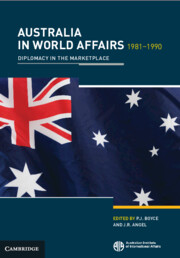Book contents
- Frontmatter
- Contents
- Preface
- Introduction
- Part 1 Australia and the World
- Part 2 Australia and the Regions
- 7 Australia and the United States
- 8 Australia and Southeast Asia
- 9 Australia and the South Pacific
- 10 Australia and the United Kingdom
- 11 Australia and Western Europe
- 12 Australia and the Eastern Bloc
- 13 Australia’s relations with Japan and the Korean Peninsula
- 14 Australia and China
- 15 The Commonwealth connection: a contemporary history and prospect
- Index
7 - Australia and the United States
from Part 2 - Australia and the Regions
Published online by Cambridge University Press: 29 March 2024
- Frontmatter
- Contents
- Preface
- Introduction
- Part 1 Australia and the World
- Part 2 Australia and the Regions
- 7 Australia and the United States
- 8 Australia and Southeast Asia
- 9 Australia and the South Pacific
- 10 Australia and the United Kingdom
- 11 Australia and Western Europe
- 12 Australia and the Eastern Bloc
- 13 Australia’s relations with Japan and the Korean Peninsula
- 14 Australia and China
- 15 The Commonwealth connection: a contemporary history and prospect
- Index
Summary
There has been a perception in Australia, at least since 1945, that official relations between Australia and the US, similar to earlier relations with Britain the first ’great and powerful friend’, have been smoother under a Liberal-Country Party (LCP) government than under Labor. There is serious disagreement, however, regarding the explanation for the difference. Although it is easy to exaggerate the differences which existed between Washington and the Labor governments of the 1940s and 1970s, US–Australian relations certainly improved when the LCP returned to office in Canberra after November 1975. Yet the material basis for the close Australian–US political-strategic cooperation of the 1960s had withered away following the American defeat in Vietnam and the election of a Democrat administration in 1976. By 1978, the USA had pulled its troops out of Taiwan and Thailand, while promising to leave Korea by 1984. So, despite the resumption of military activity in Southeast Asia in 1979, the region no longer had the global significance of previous years which had made it the venue for American military action and hence close cooperation with Australia.
Keywords
- Type
- Chapter
- Information
- Australia in World Affairs 1981–1990Diplomacy in the Marketplace, pp. 123 - 145Publisher: Cambridge University PressFirst published in: 2024



